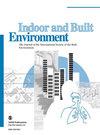大学停课可将中国学生通过密切接触传播严重急性呼吸系统综合征冠状病毒-2的风险降低60%以上
IF 2.9
3区 工程技术
Q2 CONSTRUCTION & BUILDING TECHNOLOGY
引用次数: 0
摘要
在 COVID-19 大流行期间,中国大学实施了许多预防 SAR-CoV-2 传播的干预措施。密切接触被认为是主要的传播途径。然而,人们对高校停课相关干预措施对学生感染风险的影响仍知之甚少。2022 年 7 月,我们对北京和上海的 2400 名大学生进行了在线调查。结合真实的人类行为,我们评估了大学停课和不停课期间通过密切接触感染病毒的风险。在非停课期间,本科生和研究生在教室和研究生办公室的密切接触时间最长,平均分别为 1.9 小时和 2.2 小时。在大学停课期间,学生在宿舍(宿舍和家庭)的密切接触时间最长,达到 2.8 小时。不同教育背景或性别的人接触病毒的情况没有明显差异(p > 0.05),但大学或社区的干预水平有差异(p < 0.05)。在大学停课期间,住校生的感染风险降低了 30.0%,非住校生的感染风险降低了 63.6%。这些研究结果可为COVID-19大流行等公共卫生突发事件期间的干预政策制定提供科学支持。本文章由计算机程序翻译,如有差异,请以英文原文为准。
University closures can reduce the risk of severe acute respiratory syndrome coronaviruses-2 transmission via close contact amongst Chinese students by over 60%
During the COVID-19 pandemic, Chinese universities implemented many interventions against SAR-CoV-2 transmission. Close contact is thought to be a major transmission route. However, the effect of university closure-related interventions on infection risk amongst students is still poorly understood. In July 2022, we conducted an online survey of 2,400 university students in Beijing and Shanghai. Combined with real human behaviours, we evaluated the infection risk via close contact during both periods of university closures and non-closures. During the non-closure period, undergraduate and postgraduate students spent the longest close contact time in classrooms and graduate student offices, averaging 1.9 h and 2.2 h, respectively. During university closures, students spent the longest close contact time in residences (dormitories and homes), reaching up to 2.8 h. Catering places and residences were the two main indoor environments for viral exposure via close contact. Viral exposure did not differ significantly by education background or gender ( p > 0.05) but did by intervention levels in university or community ( p < 0.05). The infection risk decreased by 30.0% for resident students and 63.6% for non-resident students during university closures. The findings could provide scientific support for intervention policy-making during public health emergencies such as COVID-19 pandemic.
求助全文
通过发布文献求助,成功后即可免费获取论文全文。
去求助
来源期刊

Indoor and Built Environment
环境科学-工程:环境
CiteScore
6.40
自引率
25.00%
发文量
130
审稿时长
2.6 months
期刊介绍:
Indoor and Built Environment publishes reports on any topic pertaining to the quality of the indoor and built environment, and how these might effect the health, performance, efficiency and comfort of persons living or working there. Topics range from urban infrastructure, design of buildings, and materials used to laboratory studies including building airflow simulations and health effects. This journal is a member of the Committee on Publication Ethics (COPE).
 求助内容:
求助内容: 应助结果提醒方式:
应助结果提醒方式:


